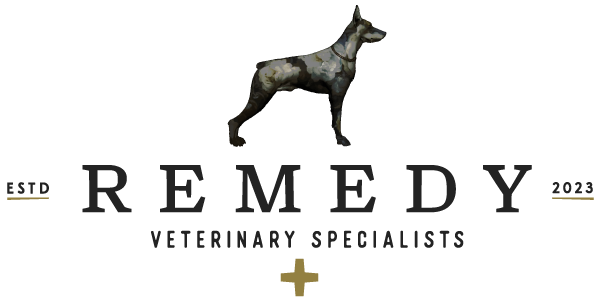Diskospondylitis
Introduction to diskospondylitis
Diskospondylitis is an infection of the intervertebral disk (the cushion that lives between the bones of the spine). We don't often know where the infection came from. Sometimes it is from a bladder or blood infection, sometimes it can be secondary to a piece of foreign material that has migrated to your dog's spine. Occasionally the infection can be secondary to a surgery or wound that was near the spine. Most dogs will have a simple bacterial infection that will be cleared with antibiotics. Because it is such a deep infection, it takes a long time for the infection to be cured, often a year or more. Most dogs feel fine after the initial treatment period. A small number of dogs will have a more serious infection, such as brucellosis or fungal diskospondylitis. Unfortunately these diseases have a worse prognosis.
Diagnosis
X-rays: It is important to Xray (radiograph) your pet's entire spine. This lets us know how many sites of infection we are dealing with. It is not uncommon for pets to have more than one site of infection and new sites can develop over time. While x-ray is a common way of finding diskospondylitis, the changes we see on X-ray can take up to four weeks. This means your dog may have symptoms, and we do not find it on the first set of X-rays. Follw-up films a month later may be necessary. We also recommend that we take X-rays every 4 months so we can track how well your pet’s treatment is going.
Bacterial Cultures: Cultures of the blood, urine and disc space are recommended to try to diagnose the exact bacteria we are dealing with. If we can find the bacteria on culture, we can also test for exactly which antibiotics will be the best choice. Unfortunately, because it is such a deep infection and the original cause may have already healed, these cultures do not grow about half the time.
Brucella Testing: We also recommend testing from brucellosis. Brucellosis is a disease that humans can catch. Even though it’s rare, it's important for your safety that we make sure your pet does not have this disease.
Fungal Testing: In dogs who are at high risk for fungal disease (certain geographic locations, immunocompromised dogs, German Shepherds), further testing may be recommended.
Additional Imaging: Diskospondylitis is often diagnosed on Xrays. Some pets, especially those with more severe symptoms, will need further imaging test such as a CT scan or MRI.
TREATMENTS
Antibiotics: Most pets will be treated at home with oral antibiotics. It’s important not to miss these antibiotics, so get them refilled one week in advance of your prescription running out.
Pain Medications: In it’s early stages, diskospondylitis is a painful condition. Your doctor will prescribed medications to help with the pain. Until the antibiotics take effect, you should give these regularly. Once the antibiotics start working, your dog will be more comfortable and you can start giving these medication on an as needed basis. If your dog becomes painful again, please let the medical team know, as this can indicate a new site of infection.
Probiotics: These medications can help prevent your dog from getting an upset stomach. If your dog is having antibiotic related GI problems, or is prone to GI problems, discuss them with your veterinarian.
Advanced Treatments: Some pet will need further treatments, such as IV antibiotics, antiinflammatories, hyperbaric oxygen therapy or even surgery to address their symptoms. Your veterinarian will discuss what therapies they believe are important to help your pet feel better as quickly as possible.
MONITORING
Please recheck one to two weeks after initial diagnosis to ensure your pet is doing well on the new medications. Long term, please schedule a recheck with the neurology team every 4 months for Xrays. If your pet develops any of the following, contact the hospital:
New or uncontrolled pain: It can take a couple of weeks after diagnosis for your pet to start feeling normal again. However, they should not be feeling more intense pain nor should they develop new sites of pain.
Incoordination: Incoordination can be a side effect of some medications, or it can be a sign that infection is pressing on the nerves or spinal cord. If your pet is uncoordinated, try to figure out if it seems to be around medication time. If it does not seem to be medication related, contact your veterinarian.
Fever/Lethargy/Inappetence: If your pet seems lethargic or is unwilling to eat/drink call your veterinarian.
Contact Us:
Mon \ Fri: 8:30am - 5:30pm
Sat: by appointment only
Phone: (415)967-3303
Email: frontdesk@remedyvets.com



